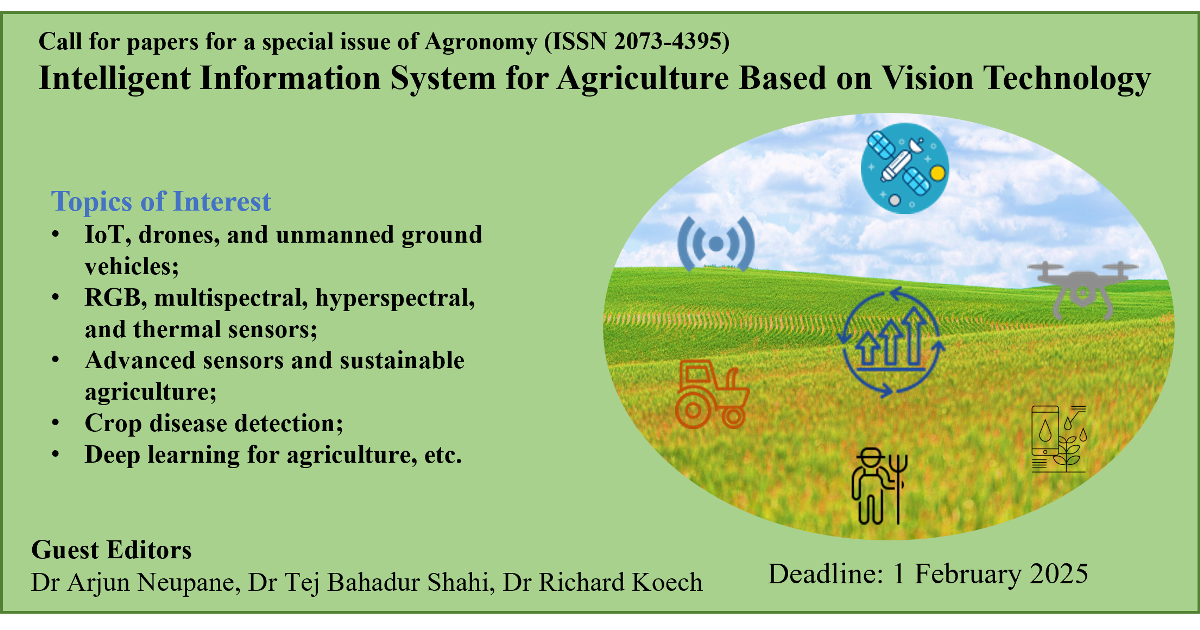- 3.4Impact Factor
- 6.7CiteScore
- 18 daysTime to First Decision
Intelligent Information System for Agriculture Based on Vision Technology
This special issue belongs to the section “Precision and Digital Agriculture“.
Special Issue Information
Dear Colleagues,
Climate change poses a significant threat to global agriculture. Various factors such as frequent drought, increasing urbanization, and soil erosion, among others, are limiting crop productivity. To tackle such challenges, modern farming is undergoing a revolution with the emergence of intelligent technology. Intelligent information systems for overall farmland are now becoming cutting-edge research areas. Unlike traditional methods, intelligent farming uses data to tailor farming practices to specific areas or even individual plants within croplands. This shift is a game-changer, paving the way for more efficient and eco-friendly food production. Advancements in sensors, data collection tools, GPS, and the Internet of Things (IoT) have opened up tremendous possibilities towards building intelligent farming systems.
Given the profound development of intelligent technology, drones, and data-driven methodologies in agriculture, this Special Issue aims to bring together the latest novel contributions within the intersection of intelligent information systems, sensors, and vision technologies.
We invite researchers to contribute original research articles, review papers, and case studies on, but not limited to, the following topics:
- Intelligent agriculture information systems;
- Big data and sustainable agriculture;
- IoT, drones, and unmanned ground vehicles;
- RGB, multispectral, hyperspectral, and thermal sensors;
- Advanced sensors and sustainable agriculture;
- Artificial intelligence and remote sensing;
- Data-driven farming;
- Affordable technology for small farmers, and so forth;
- Crop disease detection;
- Intelligent pesticide management;
- Yield estimation and crop monitoring;
- Deep learning for agriculture;
- General AI for agriculture;
- Sustainable agriculture.
Dr. Arjun Neupane
Dr. Tej Bahadur Shahi
Dr. Richard Koech
Guest Editors
Manuscript Submission Information
Manuscripts should be submitted online at www.mdpi.com by registering and logging in to this website. Once you are registered, click here to go to the submission form. Manuscripts can be submitted until the deadline. All submissions that pass pre-check are peer-reviewed. Accepted papers will be published continuously in the journal (as soon as accepted) and will be listed together on the special issue website. Research articles, review articles as well as short communications are invited. For planned papers, a title and short abstract (about 250 words) can be sent to the Editorial Office for assessment.
Submitted manuscripts should not have been published previously, nor be under consideration for publication elsewhere (except conference proceedings papers). All manuscripts are thoroughly refereed through a single-blind peer-review process. A guide for authors and other relevant information for submission of manuscripts is available on the Instructions for Authors page. Agronomy is an international peer-reviewed open access monthly journal published by MDPI.
Please visit the Instructions for Authors page before submitting a manuscript. The Article Processing Charge (APC) for publication in this open access journal is 2600 CHF (Swiss Francs). Submitted papers should be well formatted and use good English. Authors may use MDPI's English editing service prior to publication or during author revisions.
Keywords
- intelligent system
- sensors
- smart farming
- data science
- vision technology

Benefits of Publishing in a Special Issue
- Ease of navigation: Grouping papers by topic helps scholars navigate broad scope journals more efficiently.
- Greater discoverability: Special Issues support the reach and impact of scientific research. Articles in Special Issues are more discoverable and cited more frequently.
- Expansion of research network: Special Issues facilitate connections among authors, fostering scientific collaborations.
- External promotion: Articles in Special Issues are often promoted through the journal's social media, increasing their visibility.
- e-Book format: Special Issues with more than 10 articles can be published as dedicated e-books, ensuring wide and rapid dissemination.

